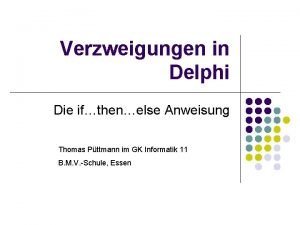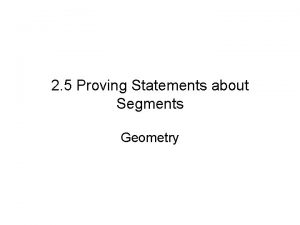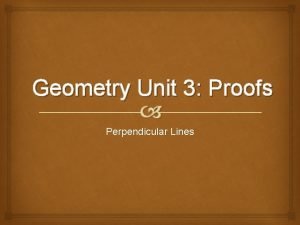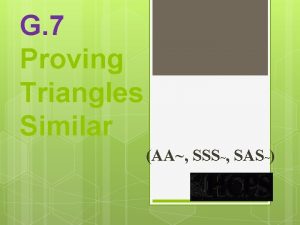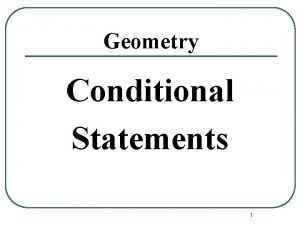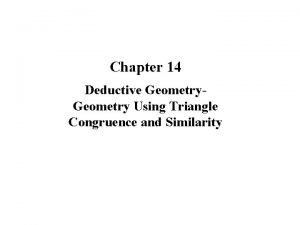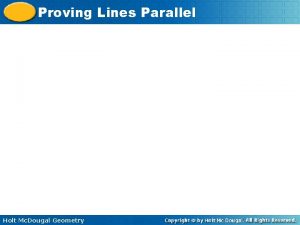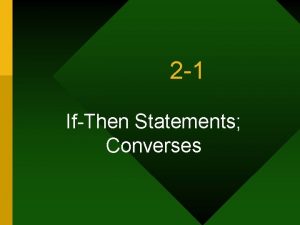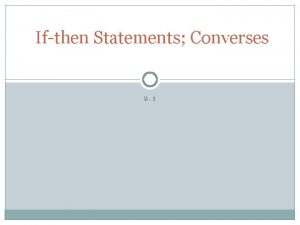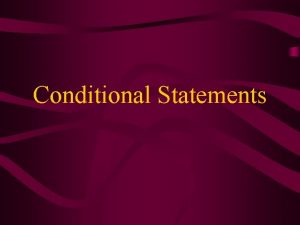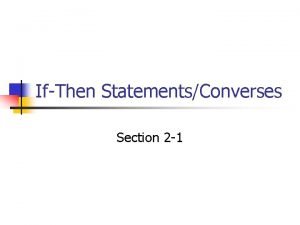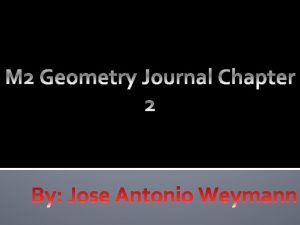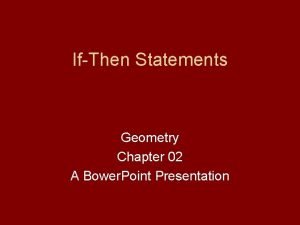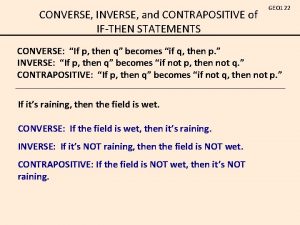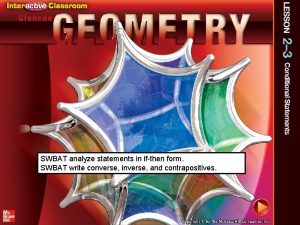Geometry 2 1 IfThen Statements Converses The foundation













- Slides: 13

Geometry 2. 1 If-Then Statements; Converses

The foundation of doing well in Geometry is knowing what the words mean. This is the first introduction to logical reasoning………

In Geometry, a student might read, “If B is between A and C, then AB + BC = AC (You know this as the Segment Addition Postulate)

If-Then To represent if-then statements symbolically, we use the basic form below: If p, then q. p: hypothesis q: conclusion

True or false? ► If you live in San Francisco, then you live in California. True

Converse ► The converse of a conditional is formed by switching the hypothesis and the conclusion: ► Statement: If p, then q. ► Converse: If q, then p. ► hypothesis conclusion

►A counterexample is an example where the hypothesis is true, but the conclusion is false. ► It takes only ONE counterexample to disprove a statement.

State whether each conditional is true or false. If false, find a counterexample. ► ► Statement: If you live in San Francisco, then you live in California. True Converse: If you live in California, then you live in San Francisco. These make the hypothesis true and conclusion false. False Counterexample: You live in Danville, Alamo, Livermore, etc. Statement: If points are coplanar, then they are collinear. Counterexample: False Converse: If points are collinear, then they are coplanar. True B It makes the hypothesis true and conclusion false. ► . . . It makes the hypothesis true and conclusion is false. If AB BC, then B is the midpoint of AC. Counterexample: False Converse: If B is the midpoint of AC, then AB True A . BC. . . C

Find a counterexample If a line lies in a vertical plane, then the line is It makes the hypothesis true and conclusion false. vertical. Counterexample: If x 2 = 49, then x = 7. Counterexample: x = -7 It makes the hypothesis true and conclusion false.

Other Forms of Conditional Statements General form If p, then q. p implies q. p only if q. q if p. Example If 6 x = 18, then x = 3. 6 x = 18 implies x = 3. 6 x = 18 only if x = 3 if 6 x = 18. These all say the same thing.

The Biconditional If a conditional and its converse are BOTH TRUE, then they can be combined into a single statement using the words “if and only if. ” This is a biconditional. p if and only if q. p q. Example: Tomorrow is Saturday if and only if today is Friday.

The Biconditional as a Definition ►A ray is an angle bisector if and only if it divides the angle into two congruent angles.

Homework P. 35 #1 -29 Odd Read 2. 2 P. 40 CE 1 -11
 Antonymy pronunciation
Antonymy pronunciation Delphi ifthen
Delphi ifthen Shallow pad foundation
Shallow pad foundation Foundation standard 1 academic foundation
Foundation standard 1 academic foundation Theory of structures
Theory of structures 4 electron domains 2 lone pairs
4 electron domains 2 lone pairs Molecular geometry and bonding theories
Molecular geometry and bonding theories Geometry statements and reasons
Geometry statements and reasons Chapter 3 proofs with perpendicular lines
Chapter 3 proofs with perpendicular lines Sas similarity theorem
Sas similarity theorem Conditional definition geometry
Conditional definition geometry Deductive geometry reasons
Deductive geometry reasons Geometry statements and reasons
Geometry statements and reasons Hát lên người ơi alleluia
Hát lên người ơi alleluia

